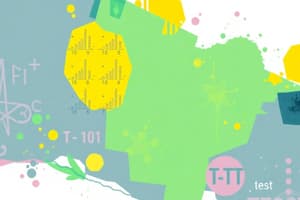Podcast
Questions and Answers
In hypothesis testing, what is the primary goal regarding the null hypothesis?
In hypothesis testing, what is the primary goal regarding the null hypothesis?
- To accept the null hypothesis as the only possible explanation.
- To ignore the null hypothesis and focus on the alternative hypothesis.
- To find sufficient evidence to reject the null hypothesis. (correct)
- To prove the null hypothesis is true.
In a repeated measures design, it is essential to have completely identical participants in each condition; matched or paired participants are not permissible.
In a repeated measures design, it is essential to have completely identical participants in each condition; matched or paired participants are not permissible.
False (B)
What is the purpose of calculating the standard error of the difference scores in a repeated measures t-test?
What is the purpose of calculating the standard error of the difference scores in a repeated measures t-test?
- To calculate the pooled variance.
- To amplify variances between the groups.
- To estimate how much the sample mean difference scores would vary from the population mean difference score if the null hypothesis is true. (correct)
- To determine whether carry-over effects are present.
When conducting an independent groups t-test with unequal sample sizes, a ______ variance estimate is used to account for differences in sample variance.
When conducting an independent groups t-test with unequal sample sizes, a ______ variance estimate is used to account for differences in sample variance.
Match the statistical assumption with its corresponding test:
Match the statistical assumption with its corresponding test:
What does the 'df' represent in the context of statistical tests?
What does the 'df' represent in the context of statistical tests?
Which of the following best describes the carry-over effects in repeated measures?
Which of the following best describes the carry-over effects in repeated measures?
In an independent groups t-test, not accounting for unequal Ns is acceptable as long as assumptions of normality are met.
In an independent groups t-test, not accounting for unequal Ns is acceptable as long as assumptions of normality are met.
What is the benefit of incorporating a control group in medical intervention studies?
What is the benefit of incorporating a control group in medical intervention studies?
In a single sample t-test, the degrees of freedom are calculated as n – ______, where n is the size.
In a single sample t-test, the degrees of freedom are calculated as n – ______, where n is the size.
What is the primary focus when interpreting results in a t-test?
What is the primary focus when interpreting results in a t-test?
In a between-subjects experimental design, the matching of participants and the process of counterbalancing the order of conditions are essential in reducing variance.
In a between-subjects experimental design, the matching of participants and the process of counterbalancing the order of conditions are essential in reducing variance.
How a repeated measures design handled statistically?
How a repeated measures design handled statistically?
If the outcome variable is of the measurement-type then the data is considered ______ in nature.
If the outcome variable is of the measurement-type then the data is considered ______ in nature.
What are the steps in conducting repeated measures?
What are the steps in conducting repeated measures?
When taking absolute values, ignore all sign changes.
When taking absolute values, ignore all sign changes.
Which test would you use when comparing 1 population means given population mean and SD?
Which test would you use when comparing 1 population means given population mean and SD?
Z and t tests are pretty ______ to violation of the normality assumption.
Z and t tests are pretty ______ to violation of the normality assumption.
When referring to observations, the [blank] samples are randomly selected to help ensure independence of observations.
When referring to observations, the [blank] samples are randomly selected to help ensure independence of observations.
A between-subjects design is the same as an independent groups.
A between-subjects design is the same as an independent groups.
What is the calculation for difference scores in a repeated measures design?
What is the calculation for difference scores in a repeated measures design?
If the IV is of the categorical type then the data is considered ______ in nature.
If the IV is of the categorical type then the data is considered ______ in nature.
To determine whether a person improves from time 1 to time 2, what sample test do you use?
To determine whether a person improves from time 1 to time 2, what sample test do you use?
Levene's test for homogeneity tests the assumptions of if the Ns are equal.
Levene's test for homogeneity tests the assumptions of if the Ns are equal.
When do we reject the null hypothesis?
When do we reject the null hypothesis?
The assumption that scores come from normally distributed populations is know as ______ normality.
The assumption that scores come from normally distributed populations is know as ______ normality.
Which of the following are single test examples?
Which of the following are single test examples?
You only need to consider carry-over effects when the subjects in a study.
You only need to consider carry-over effects when the subjects in a study.
When do we calculate pooled variance?
When do we calculate pooled variance?
If we run the study an infinite number of times of the same group, the average number of items the set of items will change due to ______ error alone.
If we run the study an infinite number of times of the same group, the average number of items the set of items will change due to ______ error alone.
Which statistical test is best suited for comparing the means of two related groups?
Which statistical test is best suited for comparing the means of two related groups?
The homogeneity of variance tests that determine if the null hypothesis is true.
The homogeneity of variance tests that determine if the null hypothesis is true.
Suppose a researcher wishes to understand relationship between political party and gender. Which analysis would be suitable?
Suppose a researcher wishes to understand relationship between political party and gender. Which analysis would be suitable?
In an independant t-test, if the means of either groups varied by chance, the chance of either random group differing would be [bank] by each set.
In an independant t-test, if the means of either groups varied by chance, the chance of either random group differing would be [bank] by each set.
Which type of tests focuses more so on what is happening to conditions/persons because of the population than what is happening to the population?
Which type of tests focuses more so on what is happening to conditions/persons because of the population than what is happening to the population?
The greater the confidence in data from larger samples, so we want weight that more.
The greater the confidence in data from larger samples, so we want weight that more.
When using two different sample groups, what will that provide an estimate for?
When using two different sample groups, what will that provide an estimate for?
Numerator is AKA the ______ differences.
Numerator is AKA the ______ differences.
There's a study on a treatment program meant to decrease social anxiety, 22 kids participated. What kind of test do we use?
There's a study on a treatment program meant to decrease social anxiety, 22 kids participated. What kind of test do we use?
There is an extra step in calculation when dealing with pooled variance.
There is an extra step in calculation when dealing with pooled variance.
In an independent groups t-test, what is the effect of unequal sample sizes on the pooled variance estimate?
In an independent groups t-test, what is the effect of unequal sample sizes on the pooled variance estimate?
In a repeated measures t-test, if the null hypothesis is actually true, the difference score between each participant will always be exactly zero.
In a repeated measures t-test, if the null hypothesis is actually true, the difference score between each participant will always be exactly zero.
When conducting an independent groups t-test, why is it important to calculate a pooled variance estimate?
When conducting an independent groups t-test, why is it important to calculate a pooled variance estimate?
In an independent groups t-test, the degrees of freedom are calculated as N₁ + N₂ - ______.
In an independent groups t-test, the degrees of freedom are calculated as N₁ + N₂ - ______.
Match the statistical test with its best description:
Match the statistical test with its best description:
Flashcards
When to use a t-test
When to use a t-test
Comparing a sample mean to a known population when variance/SD is unknown.
Repeated measures t-test
Repeated measures t-test
A statistical test comparing two sets of scores from related samples.
Independent groups t-test
Independent groups t-test
A statistical test comparing two independent groups.
Variance
Variance
Signup and view all the flashcards
Standard Deviation (SD)
Standard Deviation (SD)
Signup and view all the flashcards
P-value
P-value
Signup and view all the flashcards
Null Hypothesis (H0)
Null Hypothesis (H0)
Signup and view all the flashcards
Alternative Hypothesis (H1)
Alternative Hypothesis (H1)
Signup and view all the flashcards
Pooled Variance Estimate
Pooled Variance Estimate
Signup and view all the flashcards
Homogeneity of Variance
Homogeneity of Variance
Signup and view all the flashcards
Degrees of Freedom (df)
Degrees of Freedom (df)
Signup and view all the flashcards
Carry-over Effects
Carry-over Effects
Signup and view all the flashcards
Control Group
Control Group
Signup and view all the flashcards
Between-Subjects Design
Between-Subjects Design
Signup and view all the flashcards
Within-Subjects Design
Within-Subjects Design
Signup and view all the flashcards
SD of D scores
SD of D scores
Signup and view all the flashcards
Standard Error (SE)
Standard Error (SE)
Signup and view all the flashcards
Statistical Assumptions
Statistical Assumptions
Signup and view all the flashcards
Interpreting results
Interpreting results
Signup and view all the flashcards
Repeated measures t-test calculations
Repeated measures t-test calculations
Signup and view all the flashcards
Mean for repeated measures t-test
Mean for repeated measures t-test
Signup and view all the flashcards
Critical value
Critical value
Signup and view all the flashcards
Alpha
Alpha
Signup and view all the flashcards
Type 1
Type 1
Signup and view all the flashcards
Pooling variances
Pooling variances
Signup and view all the flashcards
What is the purpose of the independent groups t-test
What is the purpose of the independent groups t-test
Signup and view all the flashcards
Groups
Groups
Signup and view all the flashcards
Test Selection
Test Selection
Signup and view all the flashcards
Experimental Design
Experimental Design
Signup and view all the flashcards
Study Notes
- Psychological Research Methodology 2, Lecture 3 focuses on t-tests.
Overview from the Last Lecture
- Hypothesis testing looks for evidence to reject the null hypothesis.
- Single sample tests compare the mean of a sample to a known population mean.
- Population variance/SD is known via a Z test, or unknown via a t-test.
- A ratio of observed to expected differences assesses the likelihood of seeing a difference as big as the one observed, if the null hypothesis is true.
- Sample mean notation is x-bar = X.
Lecture focus
- Analyzing two sets of scores by comparing them to each other.
- This involves repeated measures t-tests (within subjects) and independent groups t-tests (between subjects).
- Includes assumptions of t-tests and practice questions.
One sample vs Two sample t-tests
- One-sample tests determine if the mean of a sampled population is the same as the mean specified in the null hypothesis.
- Two-sample tests compare two means.
Two-Sample Test Situations
- Within-subjects: the same subjects are in each condition, also known as repeated measures.
- Between-subjects: different subjects are in each condition, also known as independent groups.
Repeated Measures t-tests
- Also referred to as within-subjects t-test, correlated scores t-test, paired samples, dependent groups t-test, or matched t-test.
- Exact same people aren't always needed in each condition.
- People can be matched or paired on some relevant dimension.
Example of Repeated Measures t-test
- The study analyzes the impact of a treatment program designed to decrease social anxiety.
- 22 children are analyzed in the study.
- A trained observer coded their social anxiety level before and after treatment.
Steps of repeated measure t-tests
- State the hypotheses in words and symbols.
- Calculate the difference (D) scores using the formula X₁ - X₂.
- Calculate the standard deviation of D scores.
- Calculate the standard error of D scores.
- Calculate the t-value.
- Find the critical value for t using t-tables.
- Make a decision by comparing tobt to tcrit.
- Interpret the result.
State the Hypothesis
- Conceptual hypotheses example: Social anxiety after treatment will/will not differ from social anxiety before treatment.
- Statistical hypotheses example: H₀: μD = 0 and H₁: μD ≠ 0.
Calculate the difference (D) scores
- For each participant, the difference is calculated using X₁ - X₂.
- The mean difference score (D) is then calculated.
- Add all the difference scores, and divide by the number of participants (N).
Calculate the SD of D-scores
- Take each participant's D, subtract the mean D, and then square it.
- Add the squares together.
- Divide SSD by N-1.
Repeated Measures Designs
- More powerful than a between-subjects design because the same or closely matched people are used in both conditions.
- Need to consider carry-over effects when tested in one condition affects how participants respond in another condition.
- Counterbalance order of conditions if possible with some people do A then B, others do B then A.
- Use of control groups is important for intervention-type studies to see what happens over time without an intervention.
Independent groups t-tests and the Reading Cure
- The independent groups t-test explores if randomly selected groups differ by chance.
- It asks: at what point is a difference real (due to independent variable levels), versus due to chance.
Calculating independent groups t-tests
- Calculations differ from repeated measures t-tests because samples are independent.
- You need to look at the difference between means, not the mean difference.
- Standard error needs to be estimated by combining the variation in the two sets of scores.
- The t-value is the number of standard errors separating the two means.
- Formulas exist for equal and unequal Ns.
Sample Data
- Sample data is used to estimate population variance/SE.
- IF Ns are not equal (e.g. more people in the book condition than the control condition), the sample with the bigger N provides a better estimate of the population variance.
Pooling variance
- Calculate the standard error to calculate by pooling variance.
- Use the formulas provided for equal and unequal variances.
The independent groups t-test, is:
- Observed Difference divided by Expected Difference.
- Still dividing the difference between the sample means (observed difference) by the standard error (expected difference) to get a t value
Conceptual Meaning
- Determines if the means of the two groups differ more than you would expect via chance.
- Assessed by ratio of observed difference / expected or typical difference
COVID-19 Example
- PSYC2010 students test the effect of activating fear of COVID-19 on panic purchasing.
- 20 Participants were recruited as they entered the grocery store and assigned them randomly to the flu article condition, or the COVID article condition.
- The dependent variable analyzed how many items participants purchased while shopping.
Conduct calculations and interpret
- State the hypothesis
- Calculate SS
- Calculate pooled variance
- Calculate standard error
- Calculate t
Degrees of Freedom
- Single sample tests df = N-1
- Two sample repeated measure tests df = N-1
- Independent groups t-tests df = N1 + N2 - 2
- Look at a t distribution to find the correlation
Comparing Tests:
- Single sample tests determine the sample mean differently from the population mean.
- Repeated measures test is for differences between two matching samples and independent groups and if their difference is significant.
- In repeated measures, the same or closely matched people are measured under both conditions.
Interpret results
- The type of test will dictate the results.
Assumptions of t-tests and z-tests:
- Normality: sampling distribution is normal.
- Random Sampling: data are randomly sampled from the population.
Additional Assumptions for Independent groups t-tests
- Independence of observations (samples are randomly selected)
- Population normality, though violations aren't serious, if Ns are equal and not too small.
- Homogeneity of variance: the t-test assumes that populations have equal variances.
- You can check check assumptions using Levene's test for homogeneity of variance.
Studying That Suits You
Use AI to generate personalized quizzes and flashcards to suit your learning preferences.




